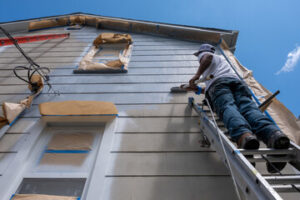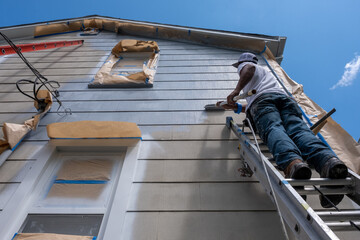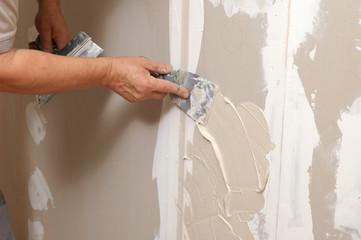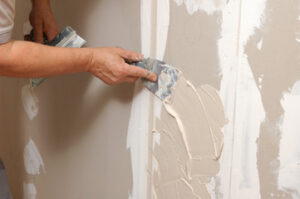Painting your home’s exterior helps increase its value and can draw potential buyers in. It also protects your house from mildew, rot, water damage, and insects.
 When choosing Exterior Painters Naperville IL ask about their experience and qualifications. They should carry liability insurance, have a license to work in your area, and provide references and reviews.
When choosing Exterior Painters Naperville IL ask about their experience and qualifications. They should carry liability insurance, have a license to work in your area, and provide references and reviews.
Homeowners have a variety of options to improve the overall look of their homes. From landscaping to exterior painting, these upgrades can make a significant impact on the curb appeal of your property. However, not all exterior enhancements are created equal. Some are more effective than others in attracting potential buyers. This is why it’s important to enlist the services of an exterior painter who can deliver a high-quality finish.
Whether it’s fresh, crisp paint or beautiful greenery, curb appeal is the first impression that home buyers will get when they approach your property. It tells them a lot about the property’s condition and care, which can be indicative of how well the interior has been maintained.
A curb appeal boost can also help your property stand out in a neighborhood full of cookie-cutter homes. It can give you an edge over other homes when it comes time to list your property for sale, making it easier to attract the attention of prospective buyers and achieve a higher selling price.
The most common element of a home’s curb appeal is its color. However, choosing the right hue can be a tricky task. It’s important to select a shade that will complement the existing architecture of your home, while still reflecting your style. A trusted exterior painter will know the best colors to choose based on your home’s location and climate. They will be able to advise you on the right shades for your home and the types of paint that will resist cracking, fading, and weathering in your area.
Another way to enhance the appearance of your property is by installing a new front door. This can be a simple and inexpensive curb appeal improvement that will catch the eye of passersby. Choose a door that matches the overall color scheme of your home, and add a few finishing touches like a swag or flag to make it more welcoming.
An exterior painter can also help you spruce up your home’s trim and shutters. They will use paints that are specially formulated for outdoor surfaces, and apply them with precision to minimize the risk of chips or peeling. They can even add protective coatings to protect your home’s exterior from moisture damage.
Aesthetics
A fresh coat of paint is more than just a way to enhance curb appeal. It is also a functional way to shield surfaces from the elements. Professional painters utilize advanced techniques and premium products to protect exterior surfaces from the damaging effects of rain, sun, wind, and general wear and tear. They also use proper preparation procedures to ensure a long-lasting, seamless finish.
Traditionally, the concept of aesthetics has been restricted to those objects that can be considered artistic, such as works of art or natural phenomena. However, in recent times, several philosophers have argued that this is an artificial restriction. They point out that terms such as beautiful and ugly, while perhaps apt in certain contexts, are too subjective and vague to divide the world successfully into those things that exemplify them and those that do not.
One such philosopher, Immanuel Kant (1724-1804), took the question of aesthetic judgment as a central topic in his Critique of Judgment. He argued that our initial aesthetic response to an object can be culturally conditioned and that even the most objective of standards will eventually give way to individual interpretation. It is also important to note that a similar reaction to an object can be very different between two individuals.
In addition to protecting exterior surfaces, a quality exterior painting job is an effective way to express personal style and elevate home values. Homeowners can choose from a variety of colors and combinations to create a unique ambiance that reflects their personalities. Choosing the right color can make a house feel like an extension of its owners and foster a sense of wellbeing and well-being.
When looking for a reputable exterior painter, homeowners should ensure that they are not being taken advantage of by inexperienced contractors. A trustworthy company will offer a free estimate and clearly explain what services will be provided. They will also make sure that the work is completed promptly. This is important because a delay in the completion of this project could lead to moisture accumulation, which can cause mold or mildew growth and ultimately damage the integrity of the home’s structure.
Weather Protection
One of the main concerns with exterior painting is safeguarding against the effects of weather on the building’s surface. The paint on your commercial building’s surfaces is subjected to several environmental factors including rain, snow, UV rays, and temperature fluctuations that can degrade the surface over time leading to peeling and rot. Exterior paint acts as a protective shield, preserving the building’s surfaces and preventing costly repairs in the future.
Choosing the right paint is essential to the success of your weatherproofing efforts. High-quality exterior paints are specifically formulated for outdoor use and often contain additives that increase durability and resistance to certain conditions. A good professional exterior painter will know the climate in your area and recommend the best type of paint for the job at hand.
Moisture damage can be especially troublesome for your home’s exterior paint. This is because moisture can work its way through tiny cracks or holes in the paint and impact the interior walls and ceilings with discoloration, mold growth, and rotting wood. The best way to protect your exterior paint from moisture damage is to ensure that it is properly maintained with touch-ups and reapplication of new coats every few years.
The right type of paint is also vital to weatherproofing. Your professional exterior painters will always choose water-resistant paints that can withstand the conditions of your climate. They will also ensure that the surfaces are properly prepared before applying any weather-resistant paint, removing all dirt and debris, repairing any cracks or chips, and using a suitable primer to maximize adhesion.
Depending on the type of paint, humidity levels, and other factors, it is a good idea to apply two coats of paint instead of just one. Adding a second coat will give you superior coverage and a much more durable finish than just one layer. However, if the weather is extremely hot, it may be necessary to wait until the weather cools down a bit before applying a second coat.
Maintenance
In addition to protecting the exterior of your home from weather damage, a fresh coat of paint can also help you sell your property. Studies show that homes with well-maintained exteriors have greater resale value than those without. Additionally, painting a home a color that appeals to prospective buyers can increase your chances of getting a full-price offer.
A good exterior painter can also perform other maintenance on your property. They can repair minor damage, such as peeling, bubbling, or cracking before it gets worse. They can also do things like caulking to ensure that moisture is not getting behind the boards. Moisture can lead to mold, rot, and warping that cannot be repaired, costing you much more money in the long run.
Other types of maintenance performed by exterior painters include pressure washing to remove dirt and debris from the surface of your house. They can also inspect and clean gutters and downspouts to ensure that they are directing water away from the house rather than into it. They can also inspect and manage nearby plants to prevent overgrowth that could impact your home’s painted surfaces.
When choosing an exterior painter, make sure that they are licensed and insured to do the work. Ask about their training and experience, and verify that they have worker’s compensation and liability insurance. They should also be able to provide references from past clients that can attest to their quality of work.
Getting regular maintenance from an experienced professional is worth the investment. It will not only protect your property and add to its curb appeal, but it will also save you money in the long run by preventing other more expensive issues.
Exterior painting is a large project, and two coats are highly recommended. Even though some paints claim to cover in one coat, a single coat does not stand up to 24-hour-a-day weather exposure for very long. Adding a second coat now will be far easier than trying to repaint your home in the future. In addition, the painters will be able to see areas that need special attention, such as wood rot, mildew, or rust that can’t be seen with the naked eye.



 Manufacturing companies frequently use staffing agencies to hire temporary workers for production surges, vacations, and labor disputes. These staffing specialists must know the different job roles within the manufacturing industry and its trends. They must also adhere to industry-specific safety regulations. These requirements include a commitment to continuous safety improvement. For more information, you can visit
Manufacturing companies frequently use staffing agencies to hire temporary workers for production surges, vacations, and labor disputes. These staffing specialists must know the different job roles within the manufacturing industry and its trends. They must also adhere to industry-specific safety regulations. These requirements include a commitment to continuous safety improvement. For more information, you can visit 
